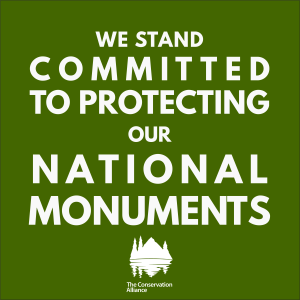
Interior Secretary Ryan Zinke today submitted a report to President Trump in which he reportedly recommends that the President alter the boundaries of some National Monuments designated since January 1996. The Interior Department did not release the full report, and provided no specifics about which monuments would be impacted, but Secretary Zinke told the Associated Press that the recommended changes would reduce the size of a “handful” of the protected areas. Zinke also told the AP that the report does not recommend rescinding any National Monument designations entirely.
“Secretary Zinke has been telegraphing for months that he would recommend shrinking some National Monuments,” said John Sterling, Executive Director of The Conservation Alliance. “If President Trump acts on those recommendations, it would be an unprecedented assault on the crown jewels of our public lands system. We stand ready to defend our National Monuments.”
“The Conservation Alliance opposes any effort to change the boundaries of existing National Monuments through executive action,” said Sterling. “The monuments under review are icons of our American landscape. They provide unique opportunities for adventure and solitude, and many have traditional value to Native American communities. National Monuments also drive local economies that benefit from related tourism and outdoor recreation.”
The White House confirmed that they received Zinke’s report, and are reviewing it. It is not clear when the White House or Interior will release the full report to the public. Secretary Zinke did release a short summary of the report that included few details, but acknowledged that public comments during the National Monument review “were overwhelmingly in favor of maintaining existing monuments.”
President Trump is likely to pursue two options for acting on the recommendations. First, he could issue an executive order changing the boundaries of one or more of the monuments under review. It is unclear whether such changes are legal, and any attempt to reduce National Monument boundaries by executive action will immediately be challenged in court.
Second, the President could issue a formal recommendation to Congress that they pass legislation to change certain National Monument boundaries. Legislation undermining existing National Monument protections would trigger a fierce battle in Congress. Nearly three million Americans submitted comments opposing any changes to the National Monuments under review, and it is certain those people will pressure their members of Congress to oppose any such legislation.
The Conservation Alliance will work closely with our member companies and our partners in the conservation community to respond to any attempt to diminish our National Monuments.
“We are prepared to use our grant program to fund litigation challenging boundary changes made by executive action,” said Sterling. “We will support grassroots conservation groups that work to organize opposition to legislative efforts to shrink monuments. And we will continue to organize our member companies and their employees and customers to speak out forcefully in support of our public lands.”


